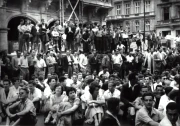Unifying and Augmenting Metadata as Linked Open Data
Lippe brick-makers project: data story
Mentions of responsibility
- Researchers: Jan Lucassen (https://orcid.org/0009-0009-6065-3947) and Piet Lourens
- Original data story ideation: Richard Zijdeman (https://orcid.org/0000-0003-3902-3720), 2021
- Links to original scans corrected by: Bram van den Hout (https://orcid.org/0000-0002-5780-3387) and Liliana Melgar (https://orcid.org/0000-0003-2003-4200), 2023
- Updated and documented by: Liliana Melgar, 2024 Date of creation: 2021 Date of last update: March 19, 2024
Motivation
This data story offers an improved way to integrate and navigate an important collection of digitized archival documents and the transcriptions and data that were extracted from those sources.
Background
"In the 19th century, up to 40% of all male workers left the Principality of Lippe every spring. Until the fall, they worked in brick works in northern Germany, the Netherlands, Scandinavia and Eastern Europe. The seasonal migrant work of the Lippe brickmakers dates back to the 17th century. The administration of the Principality of Lippe recorded them in detail. For the years from 1778 to 1869, the State Archives of North Rhine-Westphalia (LAV NRW), Department of East Westphalia-Lippe, in Detmold holds over 100,000 records on more than 30,000 brickmakers. Nowhere else in the world is it possible to find so much detailed information on seasonal workers with their origins and destinations for such a long and early period. They are invaluable for the history of migrations, work and family, but also for genealogists with ancestors from Lippe.Thanks to the cooperation between the International Institute of Social History in Amsterdam (IISG) and the LAV NRW, this data is made available embedded in its historical context." (Source: https://web.archive.org/web/20231017194904/https://iisg.nl/migration/ziegler/).
Next to the quantitative data that is presented in this data story, there is an important quantitative source publication by Lucassen en Laurens that can be consulted here: "Hollandgang im Spiegel der Reiseberichte evangelischer Geistlicher : Quellen zur saisonalen Arbeitswanderung in der zweiten Hälfte des 19. Jahrhunderts Tl. 2." (https://hdl.handle.net/10622/E93DE34F-AA90-4946-B414-F32794A7A3AC)
Access to the data
The historical documents an the data derived from these sources were/are offered in these forms:
- As digital copies of the archival records, in many cases accompanied by a transcription:
- the original sources were offered in this website: https://web.archive.org/web/20230528060856/https://www.iisg.nl/migration/ziegler/archivalien-liste.php
- the scans and their transcripts are also available at the IISH catalog: https://search.iisg.amsterdam/Record/ARCH03497 (we will come back to this form of presentation in the next section of this data story)
- the metadata of these scans and their transcripts are currently offered as a dataset: https://hdl.handle.net/10622/1RNBFT.
- As archival descriptions of the different groups of sources (descriptions of the most important fonds "L77" and "L79"):
- in the original presentation form: https://web.archive.org/web/20230604231627/https://iisg.nl/migration/ziegler/archivalien-ueber.php. See also the "Konkordanzliste" at the IISG catalog: https://search.iisg.amsterdam/Record/ARCH03497 (section "Bijlagen").
- As a database in which the personal names from the passport and brick messenger lists are stored in such a way that they can be easily searched by name, place of origin in Lippe and destination.
- this "database" was made by researchers Jan Lucassen and Piet Lourens who, for several years, transcribed the original scans and extracted details from the tables in the original sources. This "dabase" is offered at the Dataverse repository of the IISH in a comma separated value (.csv) format: https://hdl.handle.net/10622/ZKS9BA.
As a user of this collection, it is difficult to find a clear way to search and navigate across the different sources (which is explained in the next section "Defining the problem"), and to find connections between the scans and the corresponding transcripts and extracted data. This motivated the writing of this data story, which shows a more integrated way to provide such navigation between collections and data.
Defining the problem
The materials derived for the Lippische Ziegler project are described as an IISH Collection: https://hdl.handle.net/10622/ARCH03497. If you click on the tab 'content list' you'll be able to view all records within the collection. Each record consists of multiple scan, that you can can view by clicking 'online access'. To search through the archival materials go to the tab 'search in text' and enter text. This is an example of the current situation:
- If you search for the string 'lohn' in the 'search in text' tab described above, the first results mentions:
- Found on page 675 for item 4 :
- Bauerschaft 165 Lohne Hellmann Adolph Filges Meister Assemissen 165 Lohne Hellmann Fritz
- To view this text on the original scan, click on 'item 4' which will bring you to the content list tab. There click 'online access' below item 4, which will open a new page or tab with a viewer of all scans in 'item 4'. On top of the page it reads: "Image 1 of 900". Change '1' into 675 and you'll end up at the right scan. Use zoom and arrow buttons to navigate the page in more detail.
- Note: sometimes the numbering of the page is off by 1-3 pages. This alignment was corrected, and the updated links were added to the dataset: https://hdl.handle.net/10622/1RNBFT.
Solution
Storing the data
To facilitate access, the scans of the archival materials have been stored at the IISG in this dataverse: https://datasets.iisg.amsterdam/dataverse/lippe
This dataverse (or project data container) contains three datasets:
-
A dataset called "Lippe brickmakers: archival pages transcriptions" which contains the transcribed text from the archival sources mentioned above: https://hdl.handle.net/10622/1RNBFT.
-
A dataset called "Lippe brick-makers: database" which contains the structured data extracted from the transcripts by Lucassen & Lourens: https://hdl.handle.net/10622/ZKS9BA.
-
A dataset called "Lippe brick-makers database: sample with geodata" which contains a small sample from the database enriched with correct geo-data, to showcase how proper identification of place names, and its conversion to linked open data, can facilitate historical research. https://hdl.handle.net/10622/MPOWES.
Entity Recognition on 60 year old images using Yolo
Amsterdam, 2023-08-24, Rinske Zandhuis & Richard Zijdeman
Zoeken naar stakingen in Labour Conflicts database
INHOUDSOPGAVE
- Introductie / Introdcution
- Grafieken/Visualisaties / Visualizations
- 2.1. Het aantal stakingen per jaar (tijdlijn)
Strikes since a given year (timeline) - 2.2. De spreiding van stakingen in Nederland voor een periode
Spread of strikes in a time period (map) - 2.3. De top # beroepen die staakten
Top # occupations that had the most strikes (pie chart) - 2.4. De top # grootste stakingen sinds een bepaald jaar
Top # largest strikes since a given year (bar chart) - 2.5. De top #stakingen per bedrijf sinds een bepaald jaar
Top # strikes per company since a given year (by number of strikers) (bar chart) - 2.6. De resultaten van alle stakingen
Outcomes of all the strikes in the database (pie chart) - 2.7. Karakter van de stakingen
Character of the strikes - 2.8. Aantal stakingen per stad sinds 1900
Number of strikes per city since 1900
- 2.1. Het aantal stakingen per jaar (tijdlijn)
- Vragen aan de database / Questions for the database
-
3.1. Zoek een term op / Free text search
-
3.2. Zoek stakingen in een bepaald jaar / Search strikes in a year
-
3.3. Zoek stakingen in een tijd periode / Search strikes in a time period
-
3.4. Zoek stakingen in een bepaald jaar en stad / Search strikes in a year and place
-
3.5. Zoek stakingen per beroep en jaar. / Search strikes per company per year
-
Demo: transcribing videos in IISG Collection (Wim Kok Interview)
This story will explore the possibilities of extracting information from a dataset that is based on a video. The dataset contains the transcripts from the second part of Collectie Interviews Wim Kok. Every triple has a unique identifier (UID) that is connected to one transcript, URL and its start and end time in the video. If you click on the URL link, you will be directed to part of the video where that particular transcript is spoken.
Wim Kok served as Prime Minister of the Netherlands from 22 August 1994 until 22 July 2002.
Iinterviews by Leonard Ornstein, commissioned by the IISH, with Wim Kok about his time in the trade union movement, as a director at the Bouwbond NVV, and at the trade union federations NVV and FNV. This includes Kok's own career from employee Bouwbond to chairman FNV. They talk about the role of the trade union movement in the transition to decentralized wage formation and the social agreement of 1972, about social renewal and levelling, about social security and employment policy. This is interpreted within the general political and social developments of the 1960s and 1970s and the consequences of this for the relationship with the other trade union federations, with employers and the government., Interviews by Leonard Ornstein, commissioned by the IISH, with Wim Kok about his time in the trade union movement, as a director at the Bouwbond NVV, and at the trade union federations NVV and FNV.
Also see: http://hdl.handle.net/10622/COLL00306
Heterogeneity in representations of IISG film meta-data
This story draws up how film metadata is currently provided at the IISG. Most insights are from Frank de Jong, archivist at the IISG. He mentioned that metadata on movies has been stored at varying levels of granualarity. What follows are a couple of examples he mentioned.





